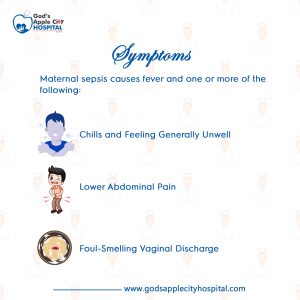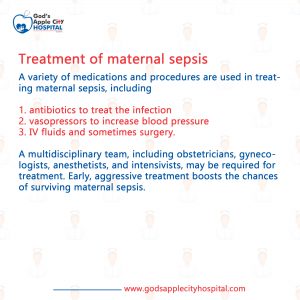What is maternal sepsis?
Maternal sepsis is a severe bacterial infection, usually of the uterus (womb), which can occur in pregnant women or more commonly, in the days following childbirth. Infection that occurs just after childbirth is also known as puerperal sepsis.
Bacteria called group A Streptococcus (GAS) are an important cause of maternal sepsis. GAS usually cause mild throat infections and skin infections, or may have no symptoms at all. However, sometimes the bacteria are able to evade the body’s normal defense mechanisms and cause sepsis. Infection may be localized to the uterus or it can spread to involve fallopian tubes and ovaries or into the blood stream.
Maternal sepsis was once a common cause of maternal death but is now rare due to improved hygiene standards and effective antibiotics.

What are the symptoms?
Maternal sepsis causes fever and one or more of the following:
- chills and feeling generally unwell
- lower abdominal pain
- foul-smelling vaginal discharge
- bleeding from the vagina (blood loss may be heavy for the first few days but will gradually become less)
- dizziness and collapse.
- Increased heart rate
If you are pregnant or have recently delivered a baby and you have any of these symptoms you need to seek medical attention urgently.


How is it spread?
Group A Streptococcus (GAS) is spread by contact with droplets from nose and throat secretions of an infected person, or by contact with infected skin lesions. Some people carry the bacteria on their skin without symptoms.
Maternal sepsis can occur when GAS is introduced into the uterus by hands, surgical or delivery instruments. GAS spreads more readily when bacteria are able to enter through a break in the skin or damaged tissue, which can occur at the time of giving birth.
GAS infection can also be caused by consumption of unpasteurised milk or unpasteurised milk products.
What are the risk factors for infection?
Risk factors for maternal sepsis include:
- Caesarean section
- Prolonged labour or early rupture of membranes
- Multiple vaginal examinations during labour
- Damaged or dead skin tissue (as a result of traumatic delivery)
- Fragments of placenta remaining in the womb after delivery
- Poor standards of hand washing and general hygiene in the days following delivery
- A sore throat or respiratory illness, or having close contact with someone with this type of illness.

Diagnosis
As with other forms of sepsis, diagnosing maternal sepsis can be difficult. Doctors often order multiple exams, including blood tests, to determine evidence of infection. They also check for abnormal vaginal discharge, edema and hypoglycemia among other symptoms. The key to early detection is to be vigilant about the risk of maternal sepsis in all pregnant women. Many hospitals are recommended to use a Modified Early Warning Scoring chart as maternal sepsis requires early detection and treatment.
Treatment
A variety of medications and procedures are used in treating maternal sepsis, including antibiotics to treat the infection, vasopressors to increase blood pressure, IV fluids and sometimes surgery. A multidisciplinary team, including obstetricians, gynecologists, anesthetists, and intensivists, may be required for treatment. Early, aggressive treatment boosts the chances of surviving maternal sepsis.

How is it prevented?
Good hygiene in the days following childbirth can reduce the risk of maternal sepsis, this includes:
- Daily bathing and showering to keep the perineum (area of skin between rectum and vagina) clean.
- Gently wiping or drying the perineum from front to back to prevent the spread of bacteria from the rectum to the bladder and vagina.
- Changing maternity pads regularly; each time you visit the toilet if pads are stained, and at least 4 times a day for the first few days.
- Not using tampons until your doctor advises you it is safe to do so.
- Washing your hands with soap and running water for at least 15 seconds before and after going to the bathroom and changing pads.
Early diagnosis of infection and early treatment can prevent life-threatening sepsis. Seek urgent medical attention if you are feeling unwell.
Kindly Check us out on
Facebook @ godsapple.hospital
Instagram @ godsapplecityhospital

